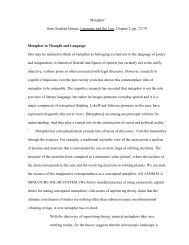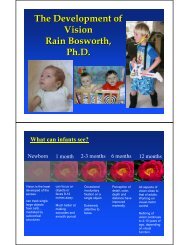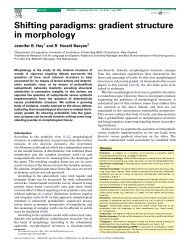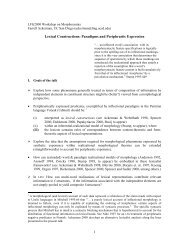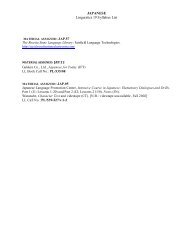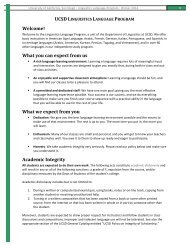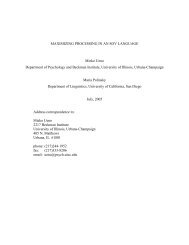Affricating ejective fricatives: The case of Tigrinya - Linguistics
Affricating ejective fricatives: The case of Tigrinya - Linguistics
Affricating ejective fricatives: The case of Tigrinya - Linguistics
You also want an ePaper? Increase the reach of your titles
YUMPU automatically turns print PDFs into web optimized ePapers that Google loves.
<strong>Affricating</strong> <strong>ejective</strong> <strong>fricatives</strong>: <strong>The</strong> <strong>case</strong> <strong>of</strong> <strong>Tigrinya</strong> 63Cutting, James E. & Burton S. Rosner. 1974. Categories and boundaries in speech and music. PerceptualPsychophysics 16(3), 564–570.Dauenhauer, Nora Marks & Richard Dauenhauer. 1991. Beginning Tlingit, 3rd edn. Juneau, AK: SealaskaHeritage Foundation Press.Demolin, Didier. 2002. <strong>The</strong> search for primitives in phonology and the explanation <strong>of</strong> sound patterns:<strong>The</strong> contribution <strong>of</strong> fieldwork studies. In Carlos Gussenhoven & Natasha Warner (eds.), Laboratoryphonology 7, 455–514. <strong>The</strong> Hague: Walter de Gruyter.Demolin, Didier. 2004. Acoustic and aerodynamic characteristics <strong>of</strong> <strong>ejective</strong>s in Amharic. Journal <strong>of</strong> theAcoustical Society <strong>of</strong> America 115(5), 2610.Denais, Michel. 1990. Eléments de phonologie et de morphologie Tigrigna. Ph.D. dissertation, Universit e⁄de Nice Sophia Antipolis.Diehl, Randy L. & Wendy A. Castleman. 1996. Integrated perceptual properties: <strong>The</strong> affricate/fricativedistinction. In Adrian P. Simpson & Matthias Pätzold (eds.), Sound patterns <strong>of</strong> connected speech:Proceedings <strong>of</strong> a symposium held at Kiel University, 191–200.Esling, John H. 1996. Pharyngeal consonants and the aryepiglottic sphincter. Journal <strong>of</strong> the InternationalPhonetic Association 26, 65–88.Esling, John H., Katherine E. Fraser & Jimmy G. Harris. 2005. Glottal stop, glottalized resonants, andpharyngeals: A reinterpretation with evidence from a laryngoscopic study <strong>of</strong> Nuuchahnulth (Nootka).Journal <strong>of</strong> Phonetics 33, 383–410Faber, Alice. 1985. Akkadian evidence for Proto-Semitic affricates. Journal <strong>of</strong> Cuneiform Studies 37(1),101–107.Faber, Alice. 2007. Genetic subgrouping <strong>of</strong> the Semitic languages. In Robert Hetzron (ed.), <strong>The</strong> Semiticlanguages, 3–15. New York: Routledge.Fitzgerald, Colleen. 2006. More on phonological variation in <strong>Tigrinya</strong>. In Siegbert Uhlig (ed.), 15thInternational Conference on Ethiopian Studies, 763–768. Wiesbaden: Harrassowitz.Fleming, Harold. 1990. A grammatical sketch <strong>of</strong> Dime (Dim - Af) <strong>of</strong> the lower Omo. In Richard Hayward(ed.), Omotic language studies, 494–583. London: School <strong>of</strong> Oriental and African Studies, University<strong>of</strong> London.Fre Woldu, Kiros. 1985. <strong>The</strong> perception and production <strong>of</strong> <strong>Tigrinya</strong> stops (Reports from Uppsala UniversityDepartment <strong>of</strong> <strong>Linguistics</strong> 13). Uppsala: Uppsala University.Garvin, Paul L. 1950. Wichita I: Phonemics. International Journal <strong>of</strong> American <strong>Linguistics</strong> 16, 179–184.Gordon, Matthew & Ayla Appelbaum. 2006. Phonetic structures <strong>of</strong> Turkish Kabardian. Journal <strong>of</strong> theInternational Phonetic Association 36(2), 159–186.Howell, Peter & Stuart Rosen. 1983. Production and perception <strong>of</strong> rise time in the voiceless affricate/fricative distinction. Journal <strong>of</strong> the Acoustical Society <strong>of</strong> America 73(3), 976–984.Jaggar, Phillip. 2001. Hausa. Amsterdam & Philadelphia: John Benjamins.Jensen, John. 1977. Yapese reference grammar. Honolulu, HI: <strong>The</strong> University Press <strong>of</strong> Hawaii.Johnson, Keith. 2003. Acoustic and auditory phonetics, 2nd edn. Oxford: Blackwell.Johnstone, Thomas M. 1975. <strong>The</strong> modern South Arabian languages. Afroasiatic <strong>Linguistics</strong> 1, 93–121.Kane, Thomas. 2000. <strong>Tigrinya</strong>–English dictionary. Kensington, MD: Dunwoody Press.Kenstowicz, Michael. 1982. Gemination and spirantization in <strong>Tigrinya</strong>. Studies in the Linguistic Sciences12, 103–122Kingston, John. 1985. <strong>The</strong> phonetics and phonology <strong>of</strong> the timing <strong>of</strong> oral and glottal events. Ph.D.dissertation, University <strong>of</strong> California at Berkeley.Kluender, Keith R. & Margaret A. Walsh. 1992. Amplitude rise time and the perception <strong>of</strong> the voicelessaffricate/fricative distinction. Perceptual Psychophysics 51(4), 328–333.Kogan, Leonid. 1997. <strong>Tigrinya</strong>. In Robert Hetzron (ed.), <strong>The</strong> Semitic languages, 424–445. New York:Taylor & Francis.Kuipers, Aert. 1960. Phoneme and morpheme in Kabardian (Eastern Adyghe). <strong>The</strong> Hague: Mouton.Ladefoged, Peter. 1993. A course in phonetics, 3rd edn. Fort Worth, TX: Harcourt Brace College.Ladefoged, Peter & Ian Maddieson. 1996. <strong>The</strong> sounds <strong>of</strong> the world’s languages. Oxford: Blackwell.Laird, Nan M. & James H. Ware. 1982. Random-effects models for longitudinal data. Biometrics 38,963–974.







